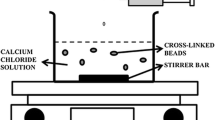Abstract
This work examines the influence of various process parameters (like sodium alginate concentration, calcium chloride concentration, and hardening time) on papain entrapped in ionotropically cross-linked alginate beads for stability improvement and site-specific delivery to the small intestine using neural network modeling. A 33 full-factorial design and feed-forward neural network with multilayer perceptron was used to investigate the effect of process variables on percentage of entrapment, time required for 50% and 90% of the enzyme release, particle size, and angle of repose. Topographical characterization was conducted by scanning electron microscopy, and entrapment was confirmed by Fourier transform infrared spectroscopy and differential scanning calorimetry. Times required for 50% (T50) and 90% (T90) of enzyme release were increased in all 3 of the process variables. Percentage entrapment and particle size were found to be directly proportional to sodium alginate concentration and inversely proportional to calcium chloride concentration and hardening time, whereas angle of repose and degree of cross-linking showed exactly opposite proportionality. Beads with >90% entrapment and T50 of <10 minutes could be obtained at the low levels of all 3 of the process variables. The inability of beads to dissolve in acidic environment, with complete dissolution in buffer of pH≥6.8, showed the suitability of beads to release papain into the small intestine. The shelf-life of the capsules prepared using the papain-loaded alginate beads was found to be 3.60 years compared with 1.01 years of the marketed formulation. It can be inferred from the above results that the proposed methodology can be used to prepare papain-loaded alginate beads for stability improvement and site-specific delivery.
Similar content being viewed by others
References
Bickerstaff GF. Immobilization of enzymes and cells: some practical considerations. In: Bickerstaff GF, ed.Immobilization of Enzymes and Cells. Totowa, NJ: Humana Press; 1997;1–12.
Uhlig H.Industrial Enzymes and their Applications. New York: Wiley; 1998.
Lin SY. Release kinetics of drug from different combined ratios of micropellets.J Microencapsul. 1993;10:319–322.
Ritschel WA. Targeting in the gastrointestinal tract: new approaches.Methods Find Exp Clin Pharmacol. 1991;13:313–336.
Chen H, Langer R. Magnetically-responsive polymerized liposomes as potential oral delivery vehicles.Pharm Res. 1997;14:537–540.
Park PG, Shalaby WSW, Park H. Physical Gels. In:Biodegradable Hydrogels for Drug Delivery. Lancaster, PA: CRC Press; 1993:99–140.
Yotsuyanagi T, Ohkubo T, Ohhashi T, Ikeda K. Calcium-induced gelation of alginic acid and pH-sensitive reswelling of dried gels.Chem. Pharm Bull. 1987;35:1555–1563.
Pillay V, Dangor CM, Govender T, Moopanar KR, Hurbans N. Drug release modulation from crosslinked calcium alginate microdises. 1. Evaluation of the concentration dependency of sodium alginate on drug entrapment capacity, morphology and dissolution rate.Drug Deliv. 1998;5:25–34.
Arica B, Calis S, Kas HS, Sargon MF, Hincal AA. 5-Fluorouracil encapsulated alginate beads for the treatment of breast cancer.Int J Pharmaceut. 2002;242:267.
Gu F, Amsden B, Neufeld R. Sustained delivery of vascular endothelial growth factor with alginate beads.J Control Release. 2004;96:463.
Almeida FP, Almeida AJ. Cross-linked alginate-gelatine beads: a new matrix for controlled release of pindolol.J Control Release. 2004;97:431–439.
Agatonovic-Kustrin S, Zecevic M, Zivanovic LJ, Tucker IG. Application of artificial neural networks in HPLC method development.J Pharm Biomed Anal. 1998;17:69–76.
Sathe PM, Venitz J. Comparison of neural network and multiple linear regression as dissolution predictors.Drug Dev Ind Pharm. 2003;29:349–355.
Takayama K, Fujukawa M, Obata Y, Morishita M. Neural network based optimization of drug formulations.Adv Drug Del Rev. 2003;55:1217–1231.
Agatonovic-Kustrin S, Beresford R. Basic concepts of artificial neural network (ANN) modeling and its application in pharmaceutical research.J Pharm Biomed Anal. 2000;22:717–727.
Winkler DA, Burden FR. Bayesian neural nets for modeling in drug discovery.Drug Discovery Today: BIOSILICO. 2004;2:104–111.
Turner JV, Maddalena DJ, Cutler DJ. Pharmacokinetic parameter prediction from drug structure using artificial neural networks.Int J Pharm. 2004;270:209–219.
Veng-Pedersen P, Modi NB. Application of neural networks to pharmacodynamics.J Pharm Sci. 1993;82:918–926.
Kachrimanis K, Karamyan V, Malamataris S. Artificial neural networks (ANNs) and modeling of powder flow.Int J Pharm. 2003;250:13–23.
Havlis J, Madden JE, Revilla AL, Havel J. High-performance liquid chromatographic determination of deoxycytidine monophosphate and methyldeoxycytidine monophosphate for DNA demethylation monitoring: experimental design and artificial neural networks optimisation.J Chromatogr B Biomed Sci Appl. 2001;755:185–194.
Dow LK, Kalelkar S, Dow ER. Self-organizing maps for the analysis of NMR spectra.Drug Discovery Today: BIOSILICO. 2004;2:157–163.
Lim CP, Quek SS, Peh KK. Prediction of drug release profiles using an intelligent learning system: an experimental study in transdermal iontophoresis.J Pharm Biomed Anal. 2003;31:159–168.
Taskinen J, Yliruusi J. Prediction of physicochemical properties based on neural network modelling.Adv Drug Deliv Rev. 2003;55:1163–1183.
Molnar L, Keseru GM, Papp A, Gulyas Z, Darvas F. A neural network based prediction of octanol-water partition coefficients using atomic5 fragmental descriptors.Bioorg Med Chem Lett. 2004;14:851–853.
Jouyban A, Majidi M-R, Jalilzadeh H, Asadpour-Zeynali K. Modeling drug solubility in water-cosolvent mixtures using an artificial neural network.Farmaco. 2004;59:505–512.
Iannuccelli V, Coppi G, Bernabei MT, Cameroni R. Air compartment multiple-unit system for prolonged gastric residence. Part I. Formulation study.Int J Pharm. 1998;174:47–54.
Wang K, He Z. Alginate-konjac glucomannan-chitosan beads as controlled release matrix.Int J Pharm. 2002;244:117–126.
Kim C-K, Lee E-J. The controlled release of blum dextran from alginate beads.Int J Pharm. 1992;79:11–19.
Ostberg T, Lund EM, Graffner C. Calcium alginate matrices for oral multiple unit administration. IV Release characteristics in different media.Int J Pharm. 1994;112:241–248.
Wong TW, Chan LW, Kho SB, Heng PWS. Design of controlled-release solid dosage forms of alginate and chitosan using microwave.J Control Release. 2002;84:99–114.
Fernandez-Hervas MJ, Holgado MA, Fini A, Fell JT. In vitro evaluation of alginate beads of a diclofenac salt.Int J Pharm. 1998;163:23–34.
Skjak-Brae G, Grasdalen KH, Draget KI, Smidsrod O. Inhomogeneous poysaccharide ionic gels.Carbohydr Polym. 1989;10:31–54.
Author information
Authors and Affiliations
Corresponding author
Additional information
Published: September 30, 2005
Rights and permissions
About this article
Cite this article
Sankalia, M.G., Mashru, R.C., Sankalia, J.M. et al. Papain entrapment in alginate beads for stability improvement and site-specific delivery: Physicochemical characterization and factorial optimization using neural network modeling. AAPS PharmSciTech 6, 31 (2005). https://doi.org/10.1208/pt060231
Received:
Accepted:
DOI: https://doi.org/10.1208/pt060231




